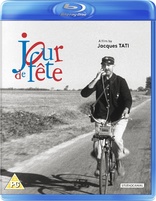Jour de fête Blu-ray Movie
HomeJour de fête Blu-ray Movie 
Holiday / RestoredStudio Canal | 1949 | 1 Movie, 3 Cuts | 79 min | Rated BBFC: U | Nov 10, 2014
Movie rating
7.2 | / 10 |
Blu-ray rating
| Users | 0.0 | |
| Reviewer | 4.0 | |
| Overall | 4.0 |
Overview
Jour de fête (1949)
The clumsy postman of a sleepy French village tries to apply more efficient, modernized methods to his mail delivery after watching an American educational film, but the results become chaotic and comical.
Starring: Guy Decomble, Paul Frankeur, Santa Relli, Maine Vallée, DelcassanDirector: Jacques Tati
| Foreign | Uncertain |
| Comedy | Uncertain |
Specifications
Video
Video codec: MPEG-4 AVC
Video resolution: 1080p
Aspect ratio: 1.37:1
Original aspect ratio: 1.37:1
Audio
French: DTS-HD Master Audio 2.0
French: DTS-HD Master Audio 2.0
French: Dolby Digital 2.0
Subtitles
English
Discs
50GB Blu-ray Disc
Single disc (1 BD)
Playback
Region B (locked)
Review
Rating summary
| Movie | 4.5 | |
| Video | 5.0 | |
| Audio | 5.0 | |
| Extras | 3.0 | |
| Overall | 4.0 |
Jour de fête Blu-ray Movie Review
Reviewed by Dr. Svet Atanasov August 1, 2014Jacques Tati's "Jour de fete" a.k.a. "Holiday" arrives on Blu-ray courtesy of StudioCanal. Included on this release are three different versions of the film: the original 1949 black-and-white version, the alternative 1964 version which features hand-painted color sequences and newly incorporated footage, and a 1994 full-color version. The supplemental features on the disc include an original trailer for the film and new documentary film by Stephane Goudet. In French, with optional English and French SDH subtitles for the main feature. Region-B "locked".
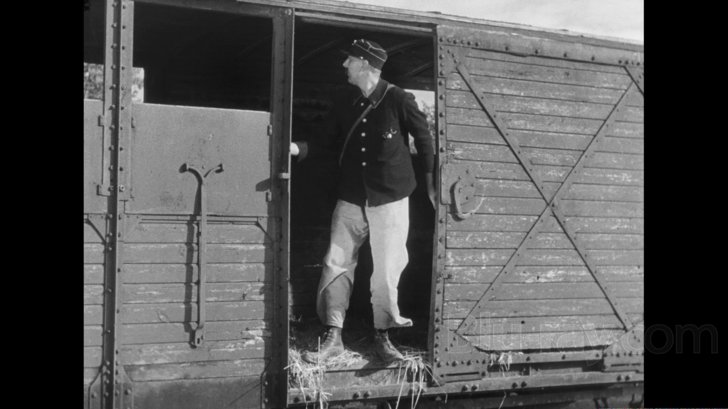
The Postman
Jour de fete is part of StudioCanal's new Jacques Tati Collection Blu-ray box set.
Jacques Tati’s first feature film follows the deeds of an ambitious postman (played by the director himself) living and working in a small French village. The majority of the time the camera simply observes Francois from afar as he rides his bike and stops for a few seconds to give or collect letters. Francois rarely speaks, and when he does, it is virtually impossible to figure out what it is that he is saying.
During a local fair, Francois watches a short film about the American postal system that quickly inspires him to change his delivery methods. Encouraged by some of his customers, he pushes himself to work twice as fast in order to maximize his efficacy. Very soon, however, his desire to impress the villagers causes all sort of serious problems and places him right in the middle of some absolutely hilarious situations.
Jour de fete is structured as a collage of short episodes, each having the postman facing some sort of a minor challenge. The manner in which he deals with these challenges is often quite amusing as the logic he follows is, to say the least, surprising. Though at times it may seem like some of the episodes are too casual, Tati’s concentration is indeed quite remarkable.
The music and different sound effects are used only as decoration. Some of the very best gags, for example, have Tati mumbling something while his body does all of the meaningful talking. He spins, jumps, runs, and gestures in ways that allow the viewer to figure out exactly what is on his mind.
The small portions of the film where the postman is missing are notably slower and feel like extracts from a documentary feature about life in rural France. Occasionally either a narrator or a secondary character would quickly describe what is taking place in front of the camera. As soon as the postman reappears, the tempo picks up again.
Tati shot Jour de fete in 1949. Initially, it was meant to use the new Thomsoncolor process and thus become the first French color film. However, well aware of the risks the process involved, Tati also shot Jour de fete with a second camera, in black and white. The black-and-white version of the film was the one that premiered in 1949.
StudioCanal's Blu-ray release of Jour de fete has three versions of the film: the original 1949 black-and-white version, which runs at approximately 87 minutes (01.26.53), the alternative 1964 version which features hand-painted color sequences and newly incorporated footage, running at approximately 80 minutes (01.20.25), and a 1994 full-color version, which runs at approximately 77 minutes (01.16.37).
Jour de fête Blu-ray Movie, Video Quality 
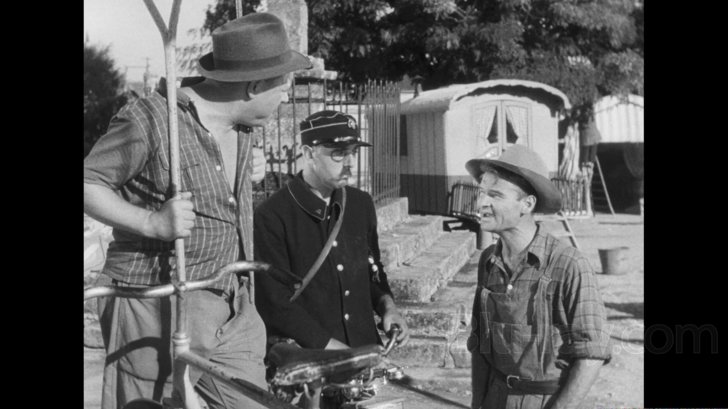
StudioCanal's Blu-ray release of Jacques Tati's Jour de fete has three versions of the film: the original 1949 black-and-white version, the alternative 1964 version which features hand-painted color sequences and newly incorporated footage, and a 1994 full-color version. The 1949 and 1964 versions are granted new MPEG-4 AVC 1080p transfers, while the 1994 version comes from a standard-definition source (upscaled).
The screencaptures included with our review appear in the following order:
1. Screencaptures #1-18: Version 1949 (01.26.53).
2. Screencaptures #21-32: Version 1964 (01.20.25).
3. Screencaptures #33-40: Version 1994 (01.16.37).
Recently restored, the 1949 version of Jour de fete looks lovely in high-definition. Depth and clarity are very pleasing. Many of the outdoor sequences, in particular, boast wonderful fluidity, while the few nighttime sequences impress with very good clarity (see screencaptures #15, 16, and 18). There are select parts of the film where obvious source limitations have affected depth and even contrast balance, but it is very easy to see that different optimizations were performed to make sure that definition is as good as possible (see screencapture #14 where some of the same vertical lines present on BFI's Thomsoncolor version of Jour de fete have been carefully toned down). There are no traces of problematic degraining and sharpening corrections. Predictably, grain is retained and appears very well resolved. This being said, there are parts of the film where fading has affected the grain structure and minor fluctuations are visible, but the film has a very convincing organic appearance. Lastly, a number of important stability enhancements have been performed. The film has been meticulously cleaned up as well.
StudioCanal's presentation of the newly restored 1964 version of Jour de fete looks vastly superior next to BFI's presentation of the same version. Not only are depth and clarity far better, but the entire film looks notably healthier -- scratches, damage marks, cuts, debris, and dirt have been carefully removed. Also, overall image stability is dramatically improved. To be perfectly clear, the shakiness and edge flicker from the BFI release are completely eliminated. The hand-painted color sequences appear more vibrant and better balanced as well (see screencaptures # 29, 30, 31). There are a few areas of the film where some minor contrast fluctuations still exist, but they are inherited. All in all, the new restoration of the 1964 version is very good and the film clearly looks the best it ever has.
The 1994 version of Jour de fete comes from a standard definition source, and it is presented here upscaled. As the screencaptures reveal, it looks quite poor.
(Note: This is a Region-B "locked" Blu-ray release. Therefore, you must have a native Region-B or Region-Free PS3 or SA in order to access its content).
Jour de fête Blu-ray Movie, Audio Quality 
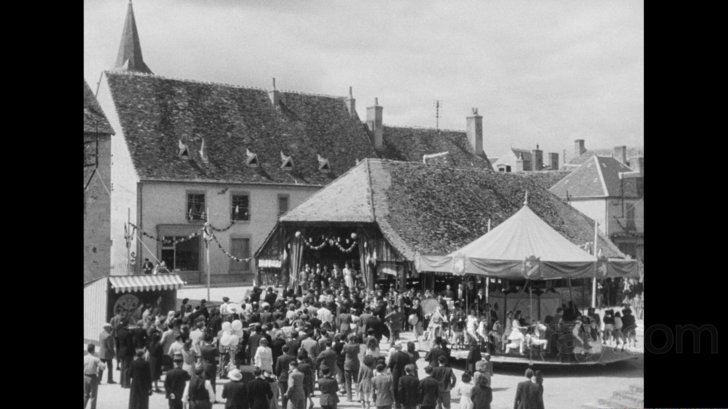
There are three standard audio tracks on this Blu-ray release: French DTS-HD Master Audio 2.0 for the 1949 version, French DTS-HD Master Audio 2.0 for the 1964 version, and French Dolby Digital 2.0 for the 1994 version. For the record, StudioCanal have provided optional English subtitles for each version.
The lossless tracks on the 1949 and 1964 versions are excellent. On the 1949 version, in particular, sound stability and depth are surprisingly good. I assume that some specific stabilization enhancements have been performed because the sound is very well balanced and there are no sudden drops or spikes in dynamic activity. Also, pops, cracks, and hiss have been removed as best as possible. (See the sequence where the postman tries to avoid the annoying bee to see how well buzzing noise is reproduced). The music is well balanced.
The 1964 version has a better range of nuanced dynamics and the music appears slightly clearer. The difference is quite obvious during the opening credits. Still, I don't think that the minor discrepancy in dynamic intensity would be noticed by too many viewers.
The 1994 version comes with a lossy track, but both clarity and depth are very good. Also, there is no problematic background hiss, audio dropouts, or distortions to report in this review.
Jour de fête Blu-ray Movie, Special Features and Extras 
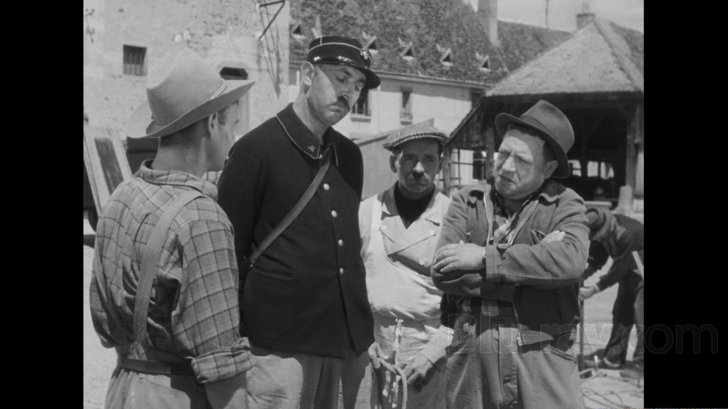
- Trailer - original trailer for Jour de fete. In French, not subtitled. (3 min).
- "American Style" - presented here is a fantastic visual analysis of Jacques Tati's Jour de fete by Stephane Goudet. There is an abundance of information in it about the film's interesting production history, the different versions of the film and the key differences between them, the origin of the gags seen in Jour de fete (which came from Jacques Tati's short films), some of the reoccurring political overtones in the French director's firms, etc. In French, with optional English subtitles. (81 min).
Jour de fête Blu-ray Movie, Overall Score and Recommendation 
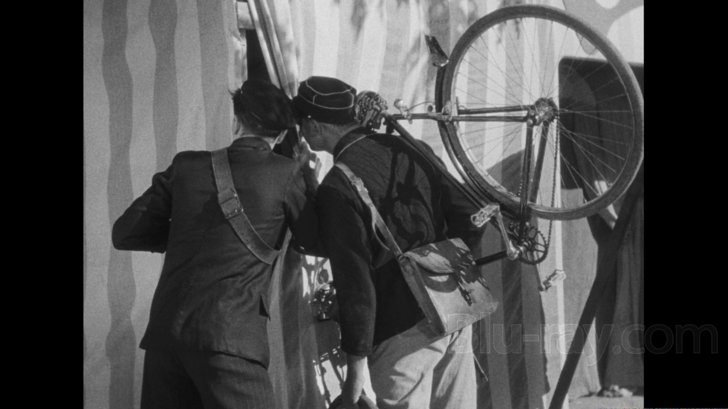
StudioCanal's Blu-ray release of Jacques Tati's Jour de fete is wonderful. Both the 1949 black-and-white version and the alternative 1964 version of the film have been recently restored and now look fantastic in high-definition. Also included on this release is a very informative new documentary film by Stephane Goudet. If you have previously purchased the BFI's Blu-ray release with the Thomsoncolor and 1964 versions of Jour de fete, do not hesitate to upgrade. These new restorations will remain the definitive presentations of the two versions of Jour de fete. VERY HIGHLY RECOMMENDED.
Other editions
Jour de fête: Other Editions
Similar titles
Similar titles you might also like
(Still not reliable for this title)

Trafic
Restored
1971

Les vacances de Monsieur Hulot
Mr. Hulot's Holiday / Restored
1953

Mon Oncle
The Jacques Tati Collection
1958

Parade
1974

Playtime
Play Time / Restored
1967

Tampopo
タンポポ / Tanpopo
1985

Deerskin
2019

Micmacs
Micmacs à tire-larigot
2009

The Gleaners & I
Les glaneurs et la glaneuse
2000

Faces Places
Visages villages
2017

All These Women
För att inte tala om alla dessa kvinnor
1964

Zazie dans le Métro
1960

Les Demoiselles de Rochefort
The Young Girls of Rochefort
1967

Smiles of a Summer Night
Sommarnattens leende
1955

I'm So Excited!
Los amantes pasajeros
2013

La Cage aux Folles
Birds of a Feather
1978

Potiche
2010

Calamari Union
1985

Lola
1961

La Règle du Jeu
The Rules of the Game
1939
